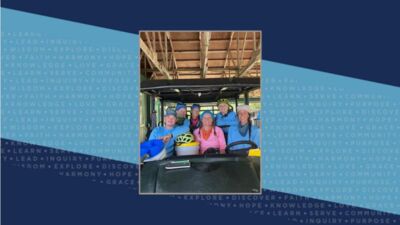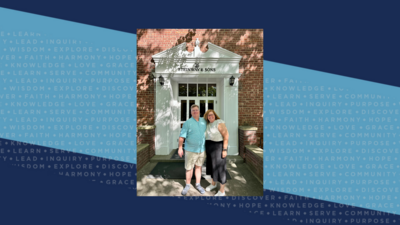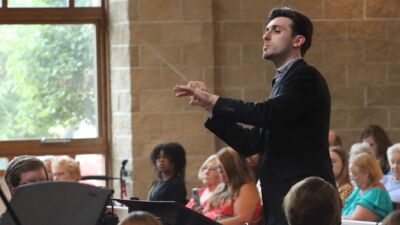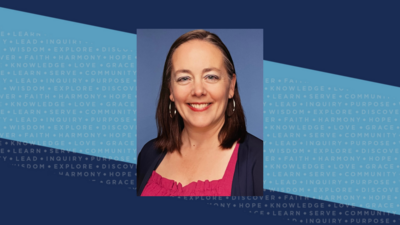Sonja M. Brandt ’21 enjoys rainforest restoration project, ornithology and marine biology on tiny island in the Pacific Ocean

Sonja M. Brandt ’21 has a bachelor of art in biology and a bachelor of fine arts in studio art from Concordia University, Nebraska. She said she didn’t put too much thought into choosing a college, because her parents attended Concordia Nebraska, as did her aunts, uncles, grandparents and numerous friends, so she decided to give it a try.
“I really enjoyed my classes and the connections I was able to make with my professors and the helpful guidance that they gave - and continue to give me - in my career and my life,” she said. “Looking back on that time of my life, I also realize how blessed I was to be surrounded by like-minded people, and people who shared my faith.”
Brandt said she always knew she wanted to do work that involved wildlife and nature.
“My professors saw that passion in me and helped make my dreams a reality by giving me the necessary knowledge to succeed in my field,” she said. “My advisor Dr. Jen Fruend and my ornithology professor Dr. Joe Gubanyi were especially helpful in giving hands-on experience in the field and providing me the opportunity to go on field trips and study tours. This experience certainly helped build my resume and gave me a deeper understanding of creation and my calling to take care of it. I am also very grateful to the art department for encouraging me to pursue my passion for art and further develop my artistic skills. I am blessed to call my professors friends, and they still give me advice on jobs and life choices. I think that’s pretty special because I know it's not something you get at a lot of other universities.”
I've come to appreciate my time at Concordia more and more as the years go by. I think it is a special place in the sense that you can tell that the people there are living for something bigger than themselves. In other words, they know what they live for, and that happens to be their faith.
In her ornithology class at the university, she said she learned a great deal about natural history, ecology and behavior of birds, which is helpful to her now in her current job. She also learned how to identify different species of birds by sight and sound, which is something she does on a regular basis, as well. Both her art and biology classes at Concordia Nebraska helped give her an eye for details, and she learned how to truly observe her surroundings.
“This skill is very important to the work I do now,” she said. “Part of my work involves monitoring the reefs for an invasive species of starfish. It is important for me to be very observant in order to see the starfish in a literal sea of many brightly colored corals and fish.”
She said her time at the university also helped to develop her faith in Jesus Christ.
“Concordia helped me develop my faith, because my professors made sure that my faith was at the center of everything that they taught,” she said. “Being surrounded by other believers definitely helped too. Concordia Nebraska also provided opportunities for me to grow and share my faith through several mission trips that I participated in during my time there. These included a trip to the village of Akiachak, Alaska, Anchorage, Alaska, Guatemala, and Uruguay.”
Brandt explained that her field of work is different from most because most people do not get a permanent position doing field/wildlife biology immediately following graduation.
“I ended up working for the Missouri Department of Conservation as a seasonal prairie ecology technician for a summer, took a job as a substitute teacher for a while, and worked another seasonal technician position as a wildlife biologist in South Texas for half a year,” she said. “In the fall of 2022, I began my master’s degree in biology at Fort Hays State University in Hays, Kansas, and worked as a graduate assistant at the Kansas Wetlands Education Center in the Cheyenne Bottoms wetland. My thesis focused on feather coloration of Cliff Swallows.”
She was awarded a fellowship to continue working on her research her second year of graduate school, and she successfully defended her thesis and graduated in May 2024.
“During my field research portion of my graduate thesis, I worked closely with The Nature Conservancy, and conducted my research in their Cheyenne Bottoms preserve,” she said. “I was awarded the Lighthouse Award for Outstanding Graduate Student at Fort Hays State University. I also maintained a 4.0 GPA throughout all of graduate school. I took the summer off for some much-needed time to relax and travel and started working yet another seasonal biology stint, this time for the United States Fish and Wildlife Service on Palmyra Atoll.”
She currently lives and works on a research station on Palmyra Atoll, a tiny island in the middle of the Pacific Ocean.
“I had three weeks of training in Hawaii before getting on a plane and flying about 1,000 miles south to the most remote place I have ever been,” she explained. “I will be here for four months with no opportunity to leave. I have only been here for a few weeks, and I love it! The only people who live on this island work at the research station. There are various research crews that will rotate through the whole time I am here, and the overall population of Palmyra Station is usually between 12 and 30 people. I work on a team of five individuals including my crew leader. I mostly work on a rainforest restoration project, but I also do some ornithology and marine biology related research.”
Palmyra Atoll is an incorporated, unorganized territory of the United States, the only one of its kind. There is no permanent population. Part of it is owned by The Nature Conservancy and part of it is a National Wildlife Refuge in the U.S. Fish and Wildlife’s refuge system. Everyone on Palmyra Station usually either works for the U.S. Fish and Wildlife or the Nature Conservancy.
“The atoll is important because the reefs around it have shown some extreme resilience to coral bleaching, a phenomenon that has decimated many other reefs in the Pacific. Finding out what makes Palmyra’s reefs so resilient could be useful to protecting other reefs,” she said. “The rainforest habitat on Palmyra is an important nesting habitat for several species of seabirds.”
The atoll was once a military base and has had several different owners over the years. Eliminating the coconut palms will help restore it to its original rainforest habitat, in turn providing the preferred nesting habitat for seabirds. There are many fascinating creatures that call the atoll home including corals, seabirds, shorebirds, tropical reef fish, blacktip reef sharks, coconut crabs, hermit crabs, spinner dolphins, melon-headed whales and manta rays.
“One of my favorite parts of Palmyra is watching the giant manta rays swim circles by the boat works under a light at night,” she said. “They all have names, and the same individuals have been coming back for years. Its Palmyra initiation to have a manta touch your toe. So my first night on Palmyra, I just had to stick my toe in the water and get a manta to swim by and touch it. I almost fell in!”
She said every day at her job is different, which is also her favorite thing about her work.
“I spend many days hacking invasive coconut palms with a machete. We use drills to inject an herbicide into the bigger trees. When I’m not chopping down coconut palms, I’m doing seabird nesting surveys, or snorkel surveys in which I take GPS tracks and report the presence or absence of invasive Crown of Thorns starfish,” she said. “I do a lot of boating, which is a skill I had to learn for this job. I also get to help out the other research teams with a lot of the other conservation and research projects going on. There’s a lot of cool work going on, including the reintroduction of a bird species that has been extinct in the wild for the past 40 years. It's been fun to learn from the other researchers and a great networking opportunity. We also have days of the week set aside where everyone pitches in to do chores or a service project on the island. It takes everyone to keep everything running smoothly. I also have some office work to do which involves entering and proofing data. There’s also a lot of gear prep work and gear clean up.”
Growing up, Brandt dreamed of becoming a marine biologist, but she was from the Midwest and went to college in the most landlocked state in North America.
“Getting necessary experience and skills to work in the field of marine biology was difficult to come by!” she said. “I’m overjoyed that I finally get a chance to do things I dreamed about doing as a kid, and I get to live on a beautiful tropical island and see sights that I could only dream about before. The project I am part of has been ongoing for several years now. I am on crew number eleven of this project and even though my contributions are small, this project has already left a very noticeable change. Islands are amazing in the sense that their ecosystems can be destroyed rather quickly but they can bounce back quickly too. The removal of the coconut palms has allowed the native vegetation to take over, providing critical nesting habitat for seabirds. I think it's fulfilling to be a part of a project that is showing signs of success and making a difference for a part of creation I really care about – birds. I also think that all the connections and networking I’ve been able to do has been fulfilling.”
Brandt’s father is an art teacher at Saint Paul Lutheran High in Concordia, Missouri, and her mother works for Lutheran Bible Translators at their headquarters. She is also a church musician. Her parents are both university alumni and her younger brothers Jacob and Andrew also graduated from the university. Her sister Ella is currently a sophomore at the university. Her youngest sister Leah plans to attend Concordia Nebraska next year.
“I've come to appreciate my time at Concordia more and more as the years go by,” she said. “I think it is a special place in the sense that you can tell that the people there are living for something bigger than themselves. In other words, they know what they live for and that happens to be their faith. That’s not really something I’ve seen a lot of in other places I’ve been.”
The biology program at Concordia Nebraska is a home for students who want to pursue their chosen vocation not for the sake of wealth, but for the sake of the Kingdom of God and the people He has placed here for us to serve. Classes and labs are taught by faculty with the highest degrees in the biological sciences who are committed to education and their students.
Interested in the biology program at Concordia?
Related Stories


